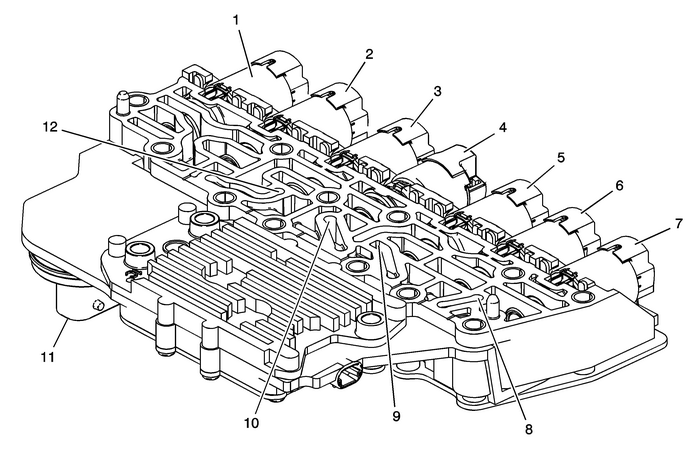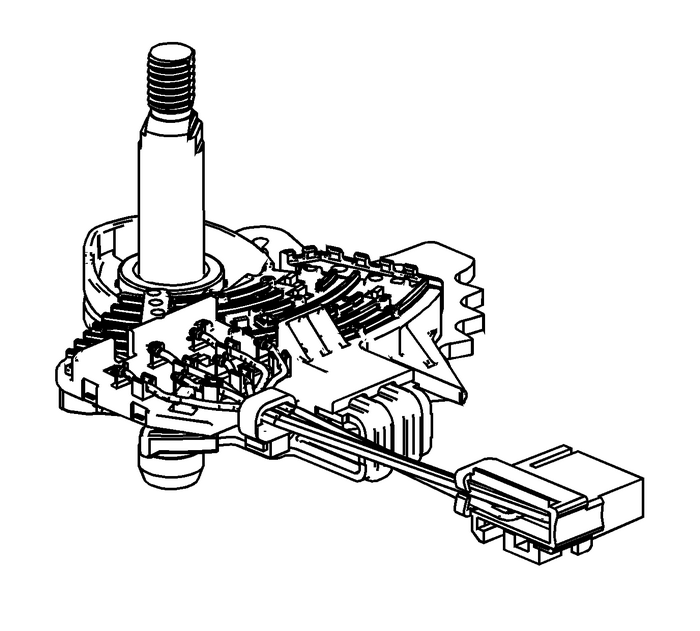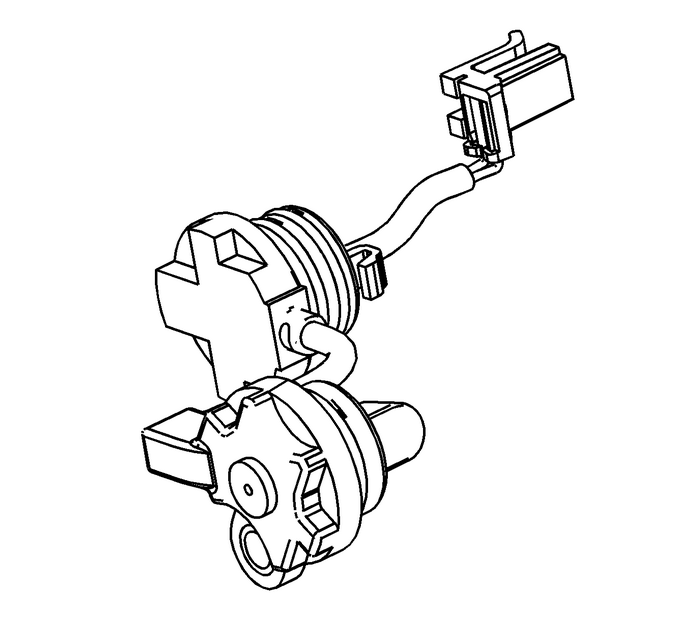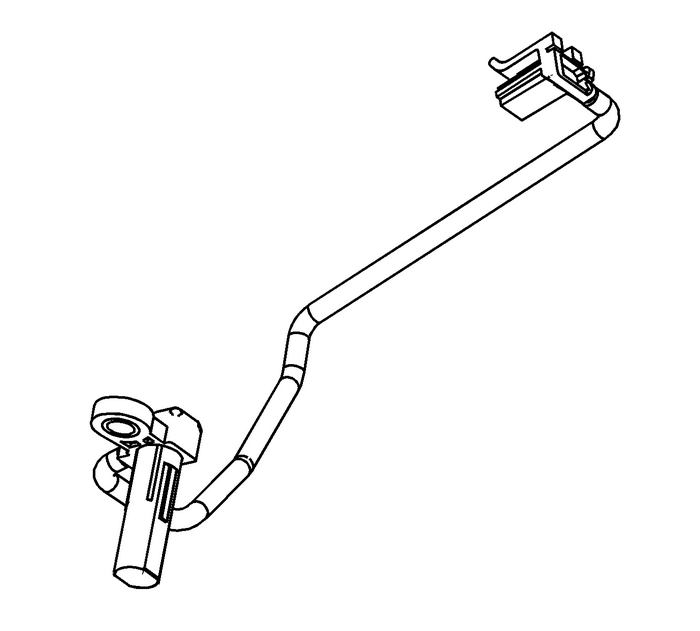Chevrolet Equinox Service Manual: Electronic Component Description Automatic Transmission Unit
Control Solenoid Valve Assembly

| (1) | Pressure ControlSolenoid-3(R-1/4-5-6) |
| (2) | (GEN-1) Pressure ControlSolenoid-2 (3-5-R) |
| (2) | (GEN-2) Pressure ControlSolenoid-5(1-2-3-4) |
| (3) | Torque ConverterClutch-(TCC) Pressure Control Solenoid |
| (4) | Shift Solenoid-1(On/Off) |
| (5) | (GEN-1) Pressure ControlSolenoid-5(1-2-3-4) |
| (5) | (GEN-2) Pressure ControlSolenoid-2 (3-5-R) |
| (6) | Pressure ControlSolenoid-4 (2-6) |
| (7) | Line Pressure ControlSolenoid |
| (8) | (GEN-1) TransmissionFluid Pressure-(TFP) Switch-1(3-5-R) |
| (9) | (GEN-1) TransmissionFluid Pressure-(TFP) Switch-3(2-6) |
| (10) | (GEN-1) TransmissionFluid Pressure-(TFP) Switch-4(1-2-3-4) |
| (11) | Pass Through Connector |
| (12) | (GEN-1) TransmissionFluid Pressure-(TFP) Switch-5(4-5-6/R-1) |
The control solenoid (w/body and TCM) valve assembly containsthe following components:
Transmission control module-(TCM)Clutch pressure control solenoids-(Clutch PCSol)Shift solenoids-(SS)Line pressure control solenoid-(Line PCSol)Torque converter clutch pressure controlsolenoid-(TCC-PC Sol)Transmission fluid temperature sensor-(TFTSensor)TCM temperature sensorPower-up temperature sensorTransmission fluid pressure switches-(TFPSw)These components are not serviced separately. The controlsolenoid (w/body and TCM) valve assembly utilizes a lead-framesystem to connect these components electrically to the TCM. Nowires are used for these components. The control solenoid (w/bodyand TCM) valve assembly bolts directly to the lower and upper valvebody assemblies inside the transmission. The control solenoid(w/body and TCM) valve assembly connects to the engine harness14-way connector.
Manual Shift Detent Lever with Shaft Position SwitchAssembly
The transmission shaft position switch assembly is a slidingcontact switch attached to the manual shaft detent lever assemblyinside the transmission case. The five inputs to the TCM from thetransmission manual shift shaft switch assembly indicate thetransmission gear selector lever position. This information is usedfor engine controls as well as determining the transmission shiftpatterns. The state of each input is available for display on thescan tool. The five input parameters represented are Signal A,Signal B, Signal C, Signal P (Parity) and Signal N (P/NStart).
Input Speed Sensor (ISS)
The input speed sensor-(ISS) is a hall-effect typesensor. The ISS mounts to the transmission case assembly andconnects to the control solenoid (w/body and TCM) valve assemblythrough a wire harness and connector. The sensor faces the 3-5-Rclutch piston housing machined teeth surface. The sensor receives8.3–9.3-volts on the ISS/OSS Supply Voltagecircuit from the TCM. As the 3-5-R/4-5-6 clutch piston housingrotates, the sensor produces a signal frequency based on themachined surface of the 3-5-R/4-5-6 clutch piston housing. Thissignal is transmitted through the ISS signal circuit to the controlsolenoid (w/body and TCM) valve assembly. The TCM uses the ISSsignal to determine line pressure, transmission shift patterns,torque converter clutch-(TCC) slip speed and gearratio.
Output Speed Sensor (OSS)
The output speed sensor-(OSS) is a hall-effecttype sensor. The OSS mounts to the transmission case below thecontrol valve body assembly and connects to the control solenoid(w/body and TCM) valve assembly through a wire harness andconnector. The sensor faces the Park gear machined teeth surface.The sensor receives 8.3–9.3-volts on theISS/OSS supply voltage circuit from the TCM. As the frontdifferential transfer drive gear assembly rotates, the sensorproduces a signal frequency based on the machined surface of thePark gear. This signal is transmitted through the OSS signalcircuit to the TCM. The TCM uses the OSS signal to determine linepressure, transmission shift patterns, torque converterclutch-(TCC) slip speed and gear ratio.
 Control Solenoid Valve and Transmission Control Module Assembly Installation Automatic Transmission Unit
Control Solenoid Valve and Transmission Control Module Assembly Installation Automatic Transmission Unit
Control Solenoid Valve and Transmission Control Module Assembly InstallationCalloutComponent Name1Control Solenoid Valve Assembly Filter PlateCaution:Use care when removing or installing the filter pl ...
 Control Valve Body - Case Side Automatic Transmission Unit
Control Valve Body - Case Side Automatic Transmission Unit
Control Valve Body-–-CaseSide(2)Line(7)Cooler Feed(9)Regulated Apply(10)Exhaust Backfill(12)PCS Line(14)Shift Solenoid(16)R1/456 Clutch Feedback(17)R1(19)Reverse(20)35 Reverse Clutch Feed(21)35 Reve ...
Other materials:
Child Restraint Systems
Rear-Facing Infant Restraint
A rear-facing child restraint provides
restraint with the seating surface
against the back of the infant.
The harness system holds the infant
in place and, in a crash, acts to
keep the infant positioned in the
restraint.
Forward-Facing Child Restraint
...
